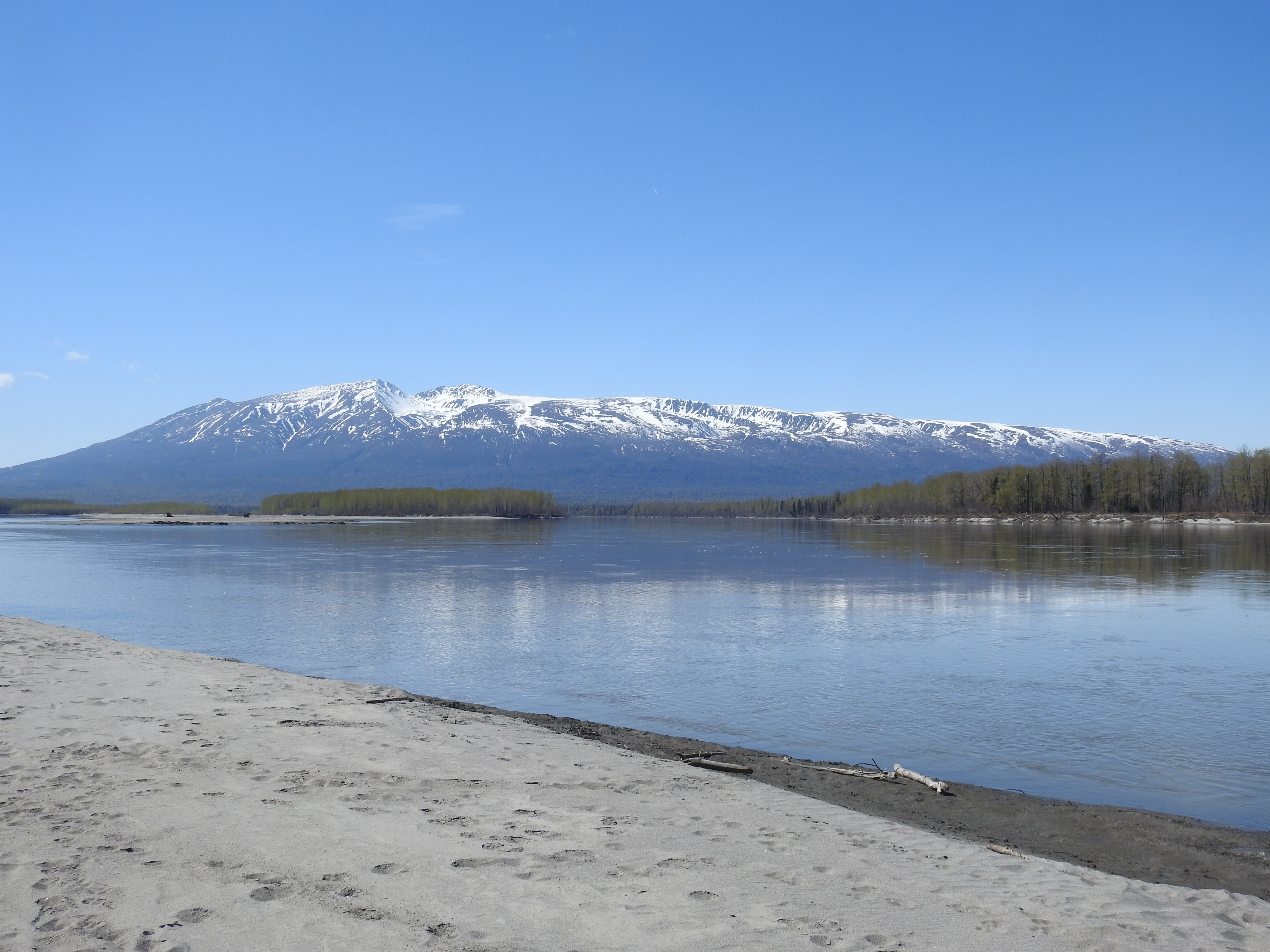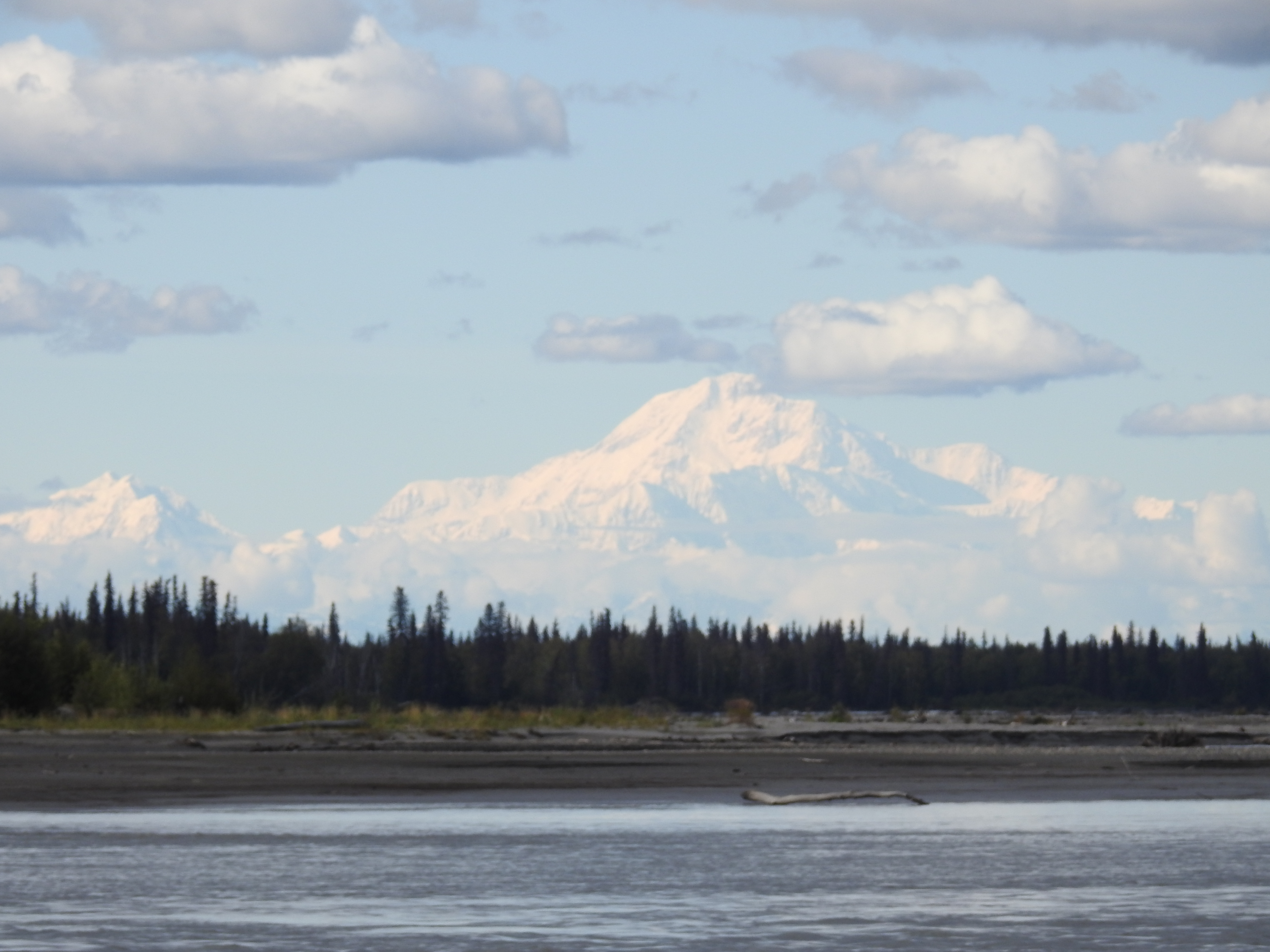
The mouth of the Susitna River is located in the Mat-Su Borough in Southcentral Alaska on the North Side of Cook Inlet in the Knik Arm across from Anchorage. It winds 313 miles into the Susitna Valley from its’ mouth in Cook Inlet to its’ headwaters at the Susitna Glacier on Mount Hayes in the Alaska Range. It is the 9th longest river in Alaska. However, by discharge volume of 51,000 cubic feet at its mouth the Susitna is ranked the 15th largest river in the United States. There is a lot of water in the Susitna River!
From Anchorage, Alaska’s largest city, people are always attracted to the sight of Mount Susitna, or as locals call her, Sleeping Lady. Looking into the horizon this mountain looms in the view on the other side of the Cook Inlet. At the mouth of the Susitna River she is only 22 miles away and as you travel upriver she is your guide. People travelling the river use her as a compass point. While travelling downstream you keep her in front of you and while travelling upstream you keep her at your back. With all of the Susitna River’s many channels this can save you if you get lost. As you continue upstream from the mouth Sleeping Lady gets closer and about 13 miles upriver she gets as close as 5 or 6 miles away.
One of the best views of Sleeping Lady from the river is at Susitna Station where I have spent many hours watching and photographing her in all her glory. Standing at our cabin there she fills the view every day. She is a beautiful sight lying there so peacefully. The Denai’ina Indians have a story that Sleeping Lady lays there vowing to sleep until her lover returns from battle. Her lover is still fighting and she continues to sleep.
It was the Dena’ina Indians who named the Susitna River. In their language the word “Susitnu” means “Sandy River”. The Denai’ina, an Athabaskan tribe, were settled in the region before white men began exploring the area in the 1800’s. An 1890 census for Susitna Station showed 146 natives living there and 27 houses. Just downriver from the original Indian settlement of Susitna Station there was also an Indian settlement at Alexander on Alexander Creek. Both Alexander and Susitna are historic settlements where to this day a few people still live the rustic river life. The Susitna River is fed by many creeks, streams and rivers. At many of the junctions where these creeks and streams and rivers join the Susitna settlements were established at one time or another. Two miles upriver from Susitna Station is the mouth of the Yenta River. The Yentna River is very popular for summer and winter recreation. People fish there in the summer and snowmachine there in the winter. A lot of people own cabins on the Yentna. The Iditarod trail runs up the Yentna River and Yentna Station - Checkpoint 1 for the Iditarod - is about 20 miles upstream from the mouth of the Yentna where it flows into the Susitna. From here it’s always fun to watch the Iditarod racers go by in February each year on their way to Nome. A little further upriver is the Deshka River which is a very popular fishing spot for Southcentral Alaskans. King Salmon and Silver Salmon run here. Salmon actually run into most of the rivers and creeks that flow into the Susitna making many of them popular fishing spots. The Willow, the Little Willow, the Kashwintna, Sheep Creek, and Montana Creek are all good waters for fishing and they are on the road system so it’s not necessary to have a boat to get to them.
Getting closer to the headwaters of the Susitna the river winds past the Talkeetna Mountains passing the town of Talkeetna with a rich history that goes back to 1916 when it was established as a mining town. The river is navigable for 85 miles upstream from its mouth to Talkeetna. Here in front of the town of Talkeetna the Chulitna and the Talkeetna Rivers join the Susitna River. Beginning in 1906 when gold was discovered at Cache Creek, the Susitna River was used as a highway into the Interior and the gold fields near Talkeetna. At the time, big steamships travelled as far as Susitna Station where they dropped passengers and supplies. From there smaller boats were used to get upstream to Talkeetna. These days Talkeetna is a very popular tourist attraction. It is known for its rustic charm and it is the gateway to Mt. McKinley. Talkeetna is where people wanting to climb Mt McKinley start their adventure. Mount McKinley, the tallest mountain in North America, comes into view on the Susitna River just upstream from the Yentna River. It is always exciting to see her looming in the distance towering over the river. As you head upriver to Talkeetna there are many spots where McKinley comes into view but once you get to Talkeetna there is an incredible view. In Talkeetna there are many sightseeing companies that will take you on boats, trains or planes to see Mt McKinley or the waters of the upper Susitna. Although most boats don’t venture past Talkeetna on the Susitna River it is possible to continue on upstream for another 60 miles or so. Some of the river boat companies take people on excursions further upstream as far as Devil’s Canyon. This trip is for the adventurous type as the water is very rapid. It’s also interesting for the history buff as the boats stop at the remains of an old trapper cabin and Indian settlement and gives you a bit of a history lesson while there. I haven’t done this trip but I would like to do it one day. If you are interested Mahays Riverboat Charters is a very experienced outfit. The owner, Steve Mahay is the first person to go through the Devil’s Canyon by boat and the only person to go through the Talkeetna Canyon. These waters are treacherous and basically leave the river impassable for the general population.
Past Devil’s Canyon the Susitna River goes east for many miles and then turns north where the Tyone River feeds into it. The interesting thing about the Tyone River is that Lake Louise, Lake Susitna and Lake Tyone all feed into the Tyone. It is possible to get to the Susitna River from Lake Louise by going through the lakes and into the Tyone which then feeds into the Susitna. However, the Tyone is winding and rocky and it’s a tough venture. Past the Tyone River the Maclaren River runs into the Susitna and as it continues north it crosses the Denali Highway and makes its way into Denali Park and to its’ headwaters at the Susitna Glacier on Mount Hayes.
The Susitna River, its’ tributaries, and surrounding waters and lands are home to abundant fish and wildlife and unsurpassed wild beauty. For those who can get there it is one of Alaska’s most popular areas for fishing, hunting and recreation, especially in the Southcentral region. It has salmon, trout, grayling, burbot and hooligan. The fishing is good year round. In the summers one can fish from a boat and in the winters through a hole in the ice. We like to fish in the lakes for pike in the winter. It’s a fun fish to catch and the more pike we can get out of the lakes the better! This fish has been decimating the salmon and trout populations in the area for years. Much of the Susitna River is off of the road system and must be accessed by boat or airplane leaving it mostly wild and in its natural state.

The area is also popular for trapping and hunting. It is teaming with birds and wildlife. There are moose, caribou, bear, ptarmigan, grouse, wolf and coyote, dahl sheep, goats, seals, otter, beaver, fox, porcupine, wolverine, ermine, squirrels, eagles, ravens, seagulls, ducks, geese and more. Travelling out on the Susitna River is excitement to the senses. There is so much to see and hear and taste and smell and touch.
It can be a dangerous place though and should be travelled with caution. It’s easy to run into problems on the river. In the summer while travelling by boat you have to be careful not to run onto sandbars and the current can be very swift and deep in places. And the water is cold. It would be dangerous to fall into this river for many reasons. It’s also easy to get lost. There are a lot of channels and the channels change every year with the freezing and thawing of the river. Each year between October and November the river freezes over for the winter. It stays frozen until April or May when the ice breaks up for the summer. During Autumn the river often floods and trees and debris are a dangerous hazard for boats. Then in the Spring after the ice goes out icebergs in the water are a hazard which you have to watch out for.
During the winter months people snowmachine and dog sled, ski and walk and even bike out on the frozen river. You must be very prepared for this type of adventure and travel should only be attempted after the ice is thick and solid enough. There is a time before the river completely freezes and before it completely thaws each year that travel on the river is unwise and at times impossible. Usually a month or so before freeze up and a month or so before break up no one travels on the river either by boat or snowmachine.
A few of the dangers in winter are the weather and the darkness. In the winter Alaska is treacherously cold and the Susitna is an isolated place. You don’t want to get stuck out in below zero temperatures miles from nowhere. Alaska is also dark for 16 hours a day in the winter which limits visibility. You have to keep on the lookout for icebergs and holes in the ice. You don’t want to have problems out on the river in winter and find yourself lost or hurt or without shelter. There is no cell service to call someone.
The Susitna River drainage has always been an area for people with a brave and a pioneering spirit. The life of the Indians, trappers, miners and those hearty people who ventured onto the river and into the wilds of Alaska lived a very adventurous life. The spirits of the people that lived on the river past and present remain and offer many interesting and exciting stories to tell. I plan to tell you a few. Stay tuned for more.


